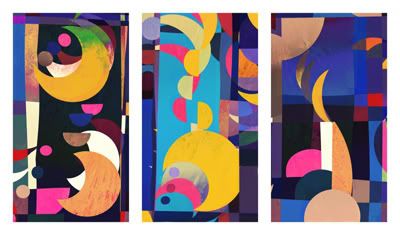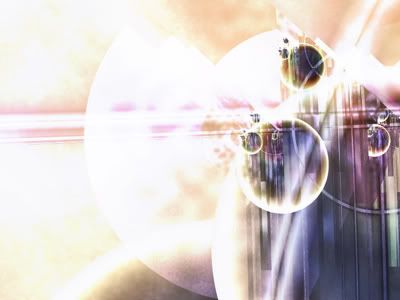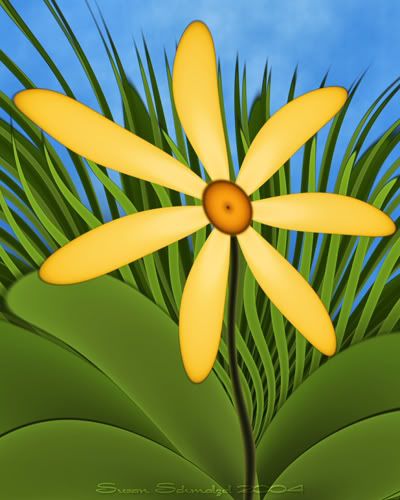Writing a blog post is not unlike beginning work on a new image. How does one even start to fill a blank screen?
When I first started blogging, I thought I had to write a certain way to fulfill (I realize now) self-determined expectations. I had to be as political or as confessional as many of the blogs I’d read. After all, blogs were being hyped to be the cutting edge of political discourse — destined to deep six the mass media giants. Or else blogs were an alternative publishing godsend to the stale cracker brittleness of the corporate monoliths. Blogs were serious business. Blog were weighty…
…weighty as a lead keyboard, or so I discovered. I hated writing “those” kinds of blogs. Who can handle all that shoulders-of-giants responsibility anyway? Besides, I felt formal and frustrated — like I was doing difficult homework I had stupidly assigned to myself. Who needs this, I thought.
But I persisted. After all, that’s what I always tell my students. Keep writing. Never throw anything away. The very act of writing will help you discover what it is you want to say. Your voice will eventually develop and become your own. Your voice…
And one day I had an epiphany. Blogs could be filled up just like any other empty notebook or web space. They could be annotated images. Or letters or poems. Or recent thoughts swarming inside one’s mental beehive. Blogs could be, in fact, the opposite of weighty. Casual as a day off. Intimate as a quiet conversation among friends.
I remembered some advice I received years ago from a college radio station director before I took to the air as a part-time student deejay. He told me not to shout or sonorously intone. He said: Pretend you are talking to one person.
So…
Hi. How are you? It’s good to see you again. It’s been too long, hasn’t it?
~/~
Morning walk;
no footprints in the snow —
but those left behind.
—Paul Cooper
Here’s an occasional and enjoyable morning ritual of mine. I pour some coffee, fire up my laptop, rummage through my bookmarks, and drop in on a few of my favorite fractal virtual “museums.” Would you like to tag along today?
XDpic202 by Joseph Presley
The first stop this morning is Joseph Presley’s The Fractal Abyss. Presley’s (and I guess I’ll use the critical formality of last names, even if I know the artist) galleries are rich and varied, and he seems equally comfortable using both Ultra Fractal and XenoDream. He also has some fascinating themed galleries centering on subjects like clockworks and musical art. The image above caused me to lean closer and almost stretch out to touch my monitor. It’s so crisp, the shadowing provides depth, and the mix of sharp and muted forms balances out the perspective nicely. It’s also a true case of art imitating life — in this instance, the naturally occurring self-similarity found in trees.
Fly Me to the Moon by Tina Oloyede
The next stop is (sort of) the ICM 2006 Benoit Mandelbrot Fractal Art Contest. If you haven’t wandered over, you owe it yourself to check out the final selections (which include some of Orbit Trap’s contributors). But, this morning, thanks to the links Dave Makin provided below, I backed up to examine all of the entries. Contest “winners” are always subjective choices and deemed so in the judges’ eye of the beholder, so I wasn’t surprised to find many striking but non-selected images that I found exciting. It’s been overcast where I live lately, so I must be starved for bright and light, and I noticed — among entrants and winners alike — that many of the contest images gravitated to shadows and darker tones. Please understand this is just an observation and not a criticism. I’m overly fond of the dark arts hues myself, and when my wife looks at new work I’ve done, she often jokes that I should “lighten up” — literally.
Anyway, my mood this morning seemed to seek out, as REM says, “Happy Shiny People.” I liked the saturated colors in Panny Brawley’s Fandango, the staccato lines and shooting rays of Harmen Wiersma’s Freedom, and the icy simplicity and bisections of Stefan Hundhammer’s Antarctica. But was Tina Oloyede’s image above that I closely studied and that lingered in my mind later. There’s nothing Fractal Noir about it. As the title implies, it’s exploding with joy — a sensual, romantic triptych. It’s like overlapping deconstructed galaxies with Miro shapes and colors. Oloyede had another image, Eifonia, selected by the panel, but it didn’t rocket me to our nearest neighbor like Fly Me to the Moon. Of course, as some of you already know, much more of Oloyede’s work can be seen at her site: aartika!
image361 by Laurent Antonini
Next, let’s beam over to Dreampaint — Laurent Antonini’s expansive site. Antonini, long known for his fractal work, has been playing more recently with Vue and Poser and composing remarkable fractal mixed media pieces, heroic fantasies / science-fiction themed images, landscapes, and some very cool seascapes. But my cursor rested on the above image when I stumbled across it in one of his Ultra Fractal galleries. In a way, it’s a companion piece for Oloyode’s image — maybe not as cheery but still definitely a cure for my morning light deprivation blues. This could be Saturn and several of its satellites seen outside one of the Voyager spacecraft’s window. The intense light pours blindingly, forcefully striking the monitor — nearly going nova as it flares on the glass. But, strangely, the image, although captivating, isn’t very warm. Instead, it’s somehow removed, suspended — somehow distant as an untouchable planet.
Rudbeckia by Susan Schmalzel
Perhaps we should pick a flower before our walk ends, so our last stop will be OT contributor Susan Schmalzel’s Studio Riverhu. She has a lovely fractal garden growing in her studio, but the above image seemed ideal to grace my screen’s vase for a time. The stalk and petal forms appear natural as they flutter in a frozen still life beneath a nearly cloudless blue sky. The flower, like a diva, holds center stage and draws in one’s gaze. Too pretty to pluck, I leave it for others to enjoy and close the screen. And so, with a mouse click, my morning walk ends.
Thanks for coming along today. I enjoyed the company. By the way, I don’t mean to imply or not imply anything about the intrinsic worth or artistic attributes of the images I’ve highlighted. Nor do I assume you should share my tastes — assuming these even are my tastes. Perhaps these images merely suited my mood this morning. Maybe tomorrow I’ll be feeling less chipper when I lumber out on a midnight stroll and drink my fill of jello shooters images of a different tone. Maybe then something like Philip Northover’s JFK will excite my senses and rev up my thoughts and set my heart racing.
Some of you might want to just stay home that night…




As a quick note, the winning ICM contest entries are now also posted on the official contest site, at http://www.fractalartcontests.com.
Terry wrote, rhetorically (which is as good as an invitation), “How does one even start to fill a blank screen?” Some people advocate a “just do anything to get started” approach, which I can do, but have rarely found productive. I don’t address a golf ball without having chosen a club and thought about the shot; I wouldn’t set up a fishing rod before getting to where I think the fish are (ok, I gave up on that after disagreements with the fish over the best weather and time of day.) So I don’t usually touch a pen, mouse or keyboard without some specific ideas already happening. For writing of any kind, the ideas get to a sufficient level of coherence or excitement that the moment I have to start writing to make sure I don’t forget anything and keep the momentum going, the instruments are transparent. Of course it helps to write down ideas when they occur at other times, so they’re ready to pick up when I need them. For writing fiction, when the characters become sufficiently real they almost write the story. Thus have I avoided the tyranny of the blank page. Except for writing tutorials. I have yet to find a process that really works for both me and the users.
For graphics I have also found it helpful to rarely begin from nothing without some specific ideas to explore. If I don’t have anything in mind, I usually open a file (or a shape memory spot) and explore variations. Anywhere there is gold, there is more gold nearby. Or a few clicks can go in radically new directions. All this is not to say that I’m taking it seriously. I just eliminate the gap between the blank paper/image and the fun part.